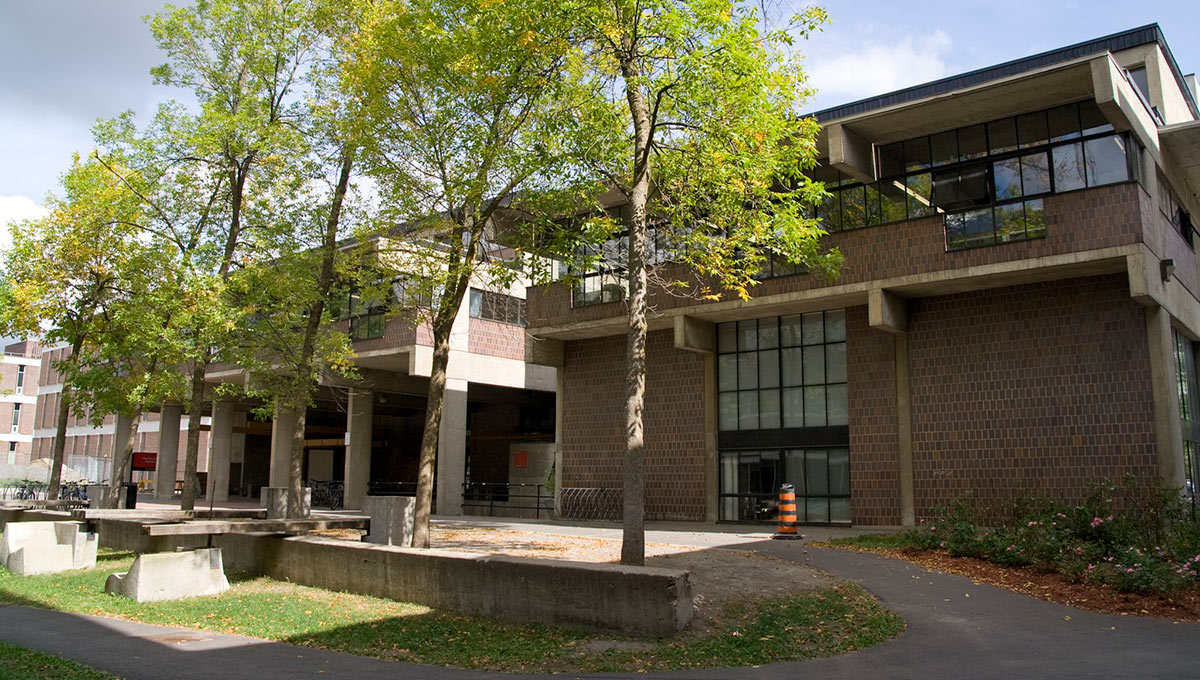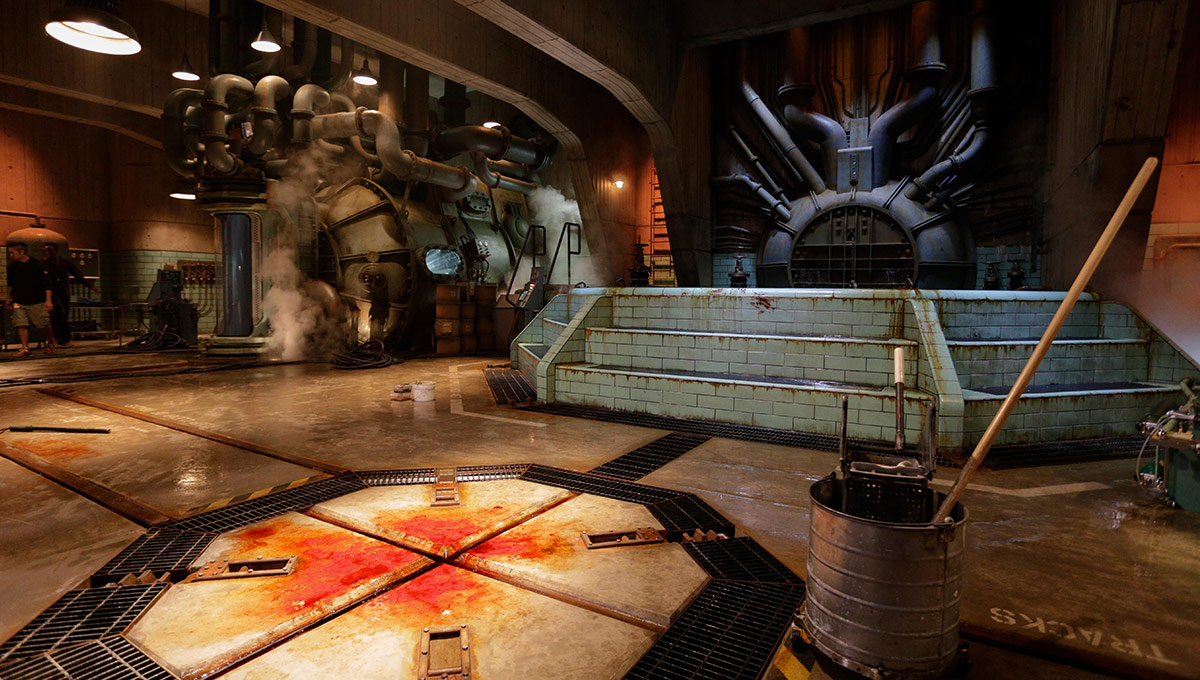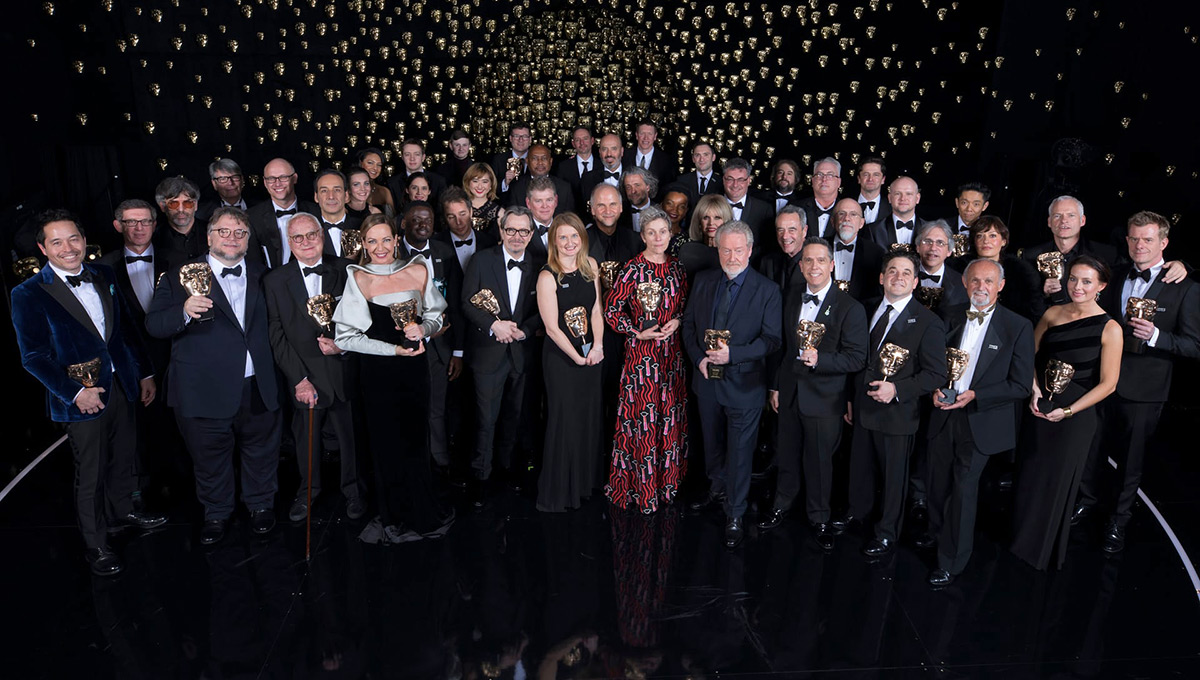By Adam Landry
UPDATE: Production designer and architecture grad, Paul Austerberry, (BArch/89) picked up an Oscar on Sunday, March 4. Austerberry, who was also honoured at the British Academy of Film and Television Awards last month, won the top Hollywood award for Best Production Design for his work on Guillermo del Toro’s The Shape of Water, named best picture of the year.
Fresh off a big win at this year’s British Academy of Film and Television Awards (BAFTAs) in London, production designer Paul Austerberry (BArch/89) has set a course for Hollywood’s biggest stage this coming Sunday. On March 4, the Carleton architecture grad will walk the red carpet at the 90th Academy Awards, hoping to take home the Oscar for Best Production Design for his work on Guillermo del Toro’s The Shape of Water.

Carleton alum and production designer Paul Austerberry (center) poses with his BAFTA in London
Where were you when you first learned that you were nominated for your work on The Shape of Water? How did you react when you received the news?
I was actually in Ottawa in a hotel lobby awaiting a taxi to the airport, having been in town for a panel discussion with (Carleton’s) School of Architecture as part of its 50th anniversary. I was super excited as you can imagine, but I was sitting in a public place so couldn’t really jump up and down!!
Did you expect the film would receive so much attention at this year’s Academy Awards?
When we were first designing and prepping the film I don’t think I could have predicted it, as the storyline is so strange and our two heroes don’t speak (and one of them is a fish man!?). However, when I saw Sally Hawkins’ work on the first day of shooting I knew it was going to be great. Still, I wouldn’t have expected a genre film to be so well received by the academy.
How did you first break into the film industry?
After graduating and moving to Toronto to work at an architectural firm, I happened to make friends with a number of people who were involved in the film industry. Over the course of the next two years, I worked within that firm before deciding to do some travel in Asia for about eight months. When I returned, there was a recession in the building industry, so I decided to volunteer in an art department on the recommendation of one of my friends. Four days into that, a paid job became available and I was in.
What initially led you to want to pursue architecture? What drew you to Carleton specifically?
From the age of 10 years old, I had wanted to become an architect. Carleton was my favourite University when I was applying in 1984 as it seemed to have the most creatively motivated curriculum in my mind.

The Architecture Building at Carleton University
In a recent interview with the LA Times, you mentioned how the Brutalist-style architecture of certain buildings at Carleton influenced your vision for elements of the film, such as the government lab where the creature is held captive. Can you elaborate?
I was referring to the style of architecture that Carleton’s Architecture Building was built in and was very common in the 1950s, ‘60s, and ‘70s for institutional buildings. I had wanted to contrast the more romantic world of Sally Hawkin’s character’s apartment above an old theatre turned movie house from the 1890s with something with harder lines and harsher materials like concrete.
How has your time at Carleton impacted your other projects? Were there influential professors or memories that you’ve drawn from?
I think that my time at Carleton has impacted pretty much all of my film projects, as the skills we learned there were really about how to look at the world around you and the visualization of three-dimensional space. We had a lot of inspirational professors, as well as an amazing array of world-renowned visiting critics such as Frank Gehry and Zaha Hadid shaping our education.
You recently spoke at the Azrieli School of Architecture and Urbanism’s Forum Lecture Series. With the school celebrating its 50th anniversary this year, why do you feel it’s important for alumni to stay connected with their alma mater?
It is important to keep a connection with your alma mater even if it is sporadic. It is great to hear how things have evolved and important to show to current students what opportunities their education might offer them upon graduation.
Where do you begin after you’ve read a script?
The first thing I always do is to break down the script into all the different locations it describes. Then you can decide which ones might be able to be found as a practical location, which ones could be created by heavily modifying an existing location, and those that need to be entirely constructed in the studio.
What was it like working with legendary fantasy director Guillermo del Toro? How were you able to translate his vision to the big screen?
It was a joy to be able to work with Guillermo, as he is such a visual director. He really celebrates the art direction in a film and it becomes an essential part of the story telling. It was a difficult task to translate his vision as written on the page, as this film had a pretty small budget for the number of sets we had to generate. We shot for almost 60 days and all but 18 of them were on location and even those locations required a substantial amount of modifications to suit the script and the 1960s time period.

An iconic set from The Shape of Water
How can the look of a film affect its story and how has your understanding of architecture helped you in establishing visual themes?
The look of a film can affect its story by creating a mood or a feeling through the use of colour or texture and shape. Warm versus a cool colour pallet, for instance, can accentuate a friendly versus a harsh environment. Softer architectural spaces can be more welcoming versus angular, sharp-lined architecture, which can sometimes feel more oppressive or aggressive. These are the kinds of tools that we can use to help set the mood and enhance the story.
What kinds of challenges did you face once you had seen the screenplay for The Shape of Water?
One of the biggest challenges we faced once we read the screenplay was how to tackle the four main underwater sequences. In the end, we resorted to only submerging one small bathroom set in a specially constructed tank and using a “dry for wet” technique for the two larger ones and the enclosed creature tank sequences. Essentially, we resorted to an old-fashioned technique of suspending the furnishing and actress by wires and filling the set with light smoke. Then we used multiple projectors to impose the caustic light, which travels through water onto the smoke and slowed it all down a bit. Visual effects added other particulate in the water as well as a few fish and, of course, animated Elisa’s hair and nightgown digitally.
You’ve worked on films from a number of blockbuster franchises, including Resident Evil, Twilight and X-Men. How different is it when taking on smaller projects like The Shape of Water?
Every scale of film has similar problems and there never seems to be enough money to do what you initially plan. For some things, it always seems to come down to not enough time or money and often it takes a lot of thinking outside the box to manage and make it all happen. I think one of the things that made The Shape of Water successful is that everything within the films works so cohesively. The lighting, the props, the costumes and sets all work harmoniously colour-wise and a big part of that is that we didn’t have that many different locations or sets so we were able to control it all.
The Shape of Water’s Canadian connections are well-known, especially with it having been shot in Toronto and Hamilton. What do you think the film’s success says about the state of the industry here in Canada?
I think is shows that there’s a lot to be proud about when it comes to the industry north of the border. Almost all of the crew for the film were Canadian and everyone’s very excited that we’ve been able to compete with the best in the world this awards season.
I’d like to point out that on this film alone there were actually four Carleton grads working in the art department, including David Fremlin (first assistant art director), William Cheng (assistant art director), Nigel Churcher (art director) and myself. There are plenty more throughout the industry in general as well.
What are you looking forward to most about attending the Oscars this coming Sunday?
I just had an incredible weekend at the BAFTAs and was able to take home an award, which is an amazing feeling. There are some incredibly beautifully crafted films this year and to be able to stand alongside them is especially fulfilling. Just being able to attend the Oscars is, of course, a great honour as it represents the pinnacle of recognition within the Hollywood film industry.

Tuesday, February 27, 2018 in Architecture, Film
Share: Twitter, Facebook



